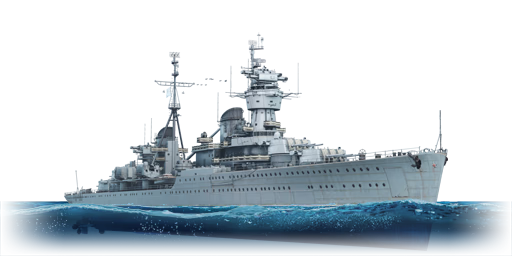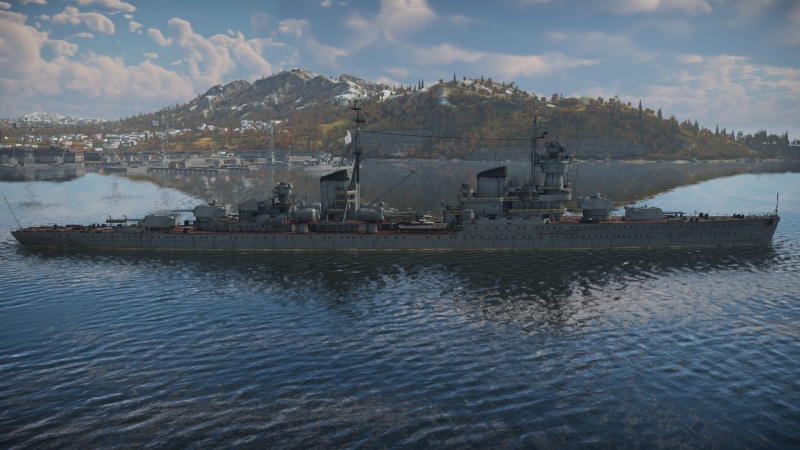Difference between revisions of "Chapayev"
(→History) (Tag: Visual edit) |
m (→Pros and cons) |
||
| Line 56: | Line 56: | ||
'''Pros:''' | '''Pros:''' | ||
| − | * | + | *Has great survivability given her crew count |
| + | *AAA is slow but effective its advised you use HE-VT for 100MM secondaries | ||
| + | *Very maneuverable | ||
| + | * Can take a few torps if they hit near the center of the boat | ||
'''Cons:''' | '''Cons:''' | ||
Revision as of 19:12, 8 March 2021
Contents
Description
The Pr.68-K, Chapayev, 1950 is a rank Soviet light cruiser with a battle rating of (AB), (RB), and (SB). It was introduced in Update 1.91 "Night Vision".
General info
Survivability and armour
Strong armour against any and all 155 mm shells, only constant AP fire from the likes of the USS Brooklyn will cause enough damage to put a dent in your crew count. Against 8-inch shells, it is recommended to angle your hull 45 degrees towards the attacker to avoid penetrating hits to your ammunition and engine compartments. Against the Admiral Graf Spee, it is adviced to pray and/or hope the enemy ship is using high-explosive shells.
The Chapayev turrets are immune to HE and AP shells from destroyers, as well resistance against being incapacitated from enemy secondary guns that ships like the IJN Mogami and the Kirov suffer from a lot. Against cruisers, the turrets are quite resistant to their high-explosive shells aside from the lucky shell that will hit one of the gun breeches, which will disable only one out of the three guns on the turret.
Deck armour is strong enough to resist 250 kg bombs, but heavier ones will cause catastrophic damage.
Mobility
The Chapayev possess an average maximum speed with somewhat quick acceleration. The rudder is very responsive for a cruiser, but the ship tends to list a lot from the tiniest rudder movements and takes a while to recover, which can mess up gun accuracy.
Modifications and economy
Armament
Primary armament
Provide information about the characteristics of the primary armament. Evaluate their efficacy in battle based on their reload speed, ballistics and the capacity of their shells. Add a link to the main article about the weapon: {{main|Weapon name (calibre)}}. Broadly describe the ammunition available for the primary armament, and provide recommendations on how to use it and which ammunition to choose.
Secondary armament
Some ships are fitted with weapons of various calibres. Secondary armaments are defined as weapons chosen with the control Select secondary weapon. Evaluate the secondary armaments and give advice on how to use them. Describe the ammunition available for the secondary armament. Provide recommendations on how to use them and which ammunition to choose. Remember that any anti-air armament, even heavy calibre weapons, belong in the next section. If there is no secondary armament, remove this section.
Anti-aircraft armament
An important part of the ship's armament responsible for air defence. Anti-aircraft armament is defined by the weapon chosen with the control Select anti-aircraft weapons. Talk about the ship's anti-air cannons and machine guns, the number of guns and their positions, their effective range, and about their overall effectiveness – including against surface targets. If there are no anti-aircraft armaments, remove this section.
Usage in battles
Describe the technique of using this ship, the characteristics of her use in a team and tips on strategy. Abstain from writing an entire guide – don't try to provide a single point of view, but give the reader food for thought. Talk about the most dangerous opponents for this vehicle and provide recommendations on fighting them. If necessary, note the specifics of playing with this vehicle in various modes (AB, RB, SB).
Pros and cons
Summarise and briefly evaluate the vehicle in terms of its characteristics and combat effectiveness. Mark its pros and cons in the bulleted list. Try not to use more than 6 points for each of the characteristics. Avoid using categorical definitions such as "bad", "good" and the like - use substitutions with softer forms such as "inadequate" and "effective".
Pros:
- Has great survivability given her crew count
- AAA is slow but effective its advised you use HE-VT for 100MM secondaries
- Very maneuverable
- Can take a few torps if they hit near the center of the boat
Cons:
History
The Soviet cruiser Chapayev (Чапаев) was the lead ship of her class of light cruisers built for the Soviet Navy before and after the Second World War. Initially designed as a follow-up to the previous Kirov-class cruisers, the ship was laid down and launched at the start of the Second World War before construction was halted due to the German invasion. Chapayev was completed after the war, albeit to an altered design with heavily-increased anti-aircraft armament. However, due to the advent of advanced weapons systems such as guided missiles, the ship was made obsolete extremely quickly. Chapayev was reduced to a training ship in 1960, and sold for scrap by 1963.
Design and development
The Chapayev class, or Project 68, was designed as a follow up to the previous Kirov class of light cruisers. The ships were designed with a new main armament of twelve 6-inch guns, compared to the nine 7-inch guns of the Kirov class. The ship was also significantly larger, displacing almost 5000 tons more than the preceding Kirovs. Initially, it was planned that a total of 17 ships would be built, but only seven ships had been started when the Germans invaded. The Chapayev was the first of these ships, launched in 1941 just before the invasion. Two of the seven hulls were destroyed on their slipways by the German forces, but the remaining five vessels were completed after the war in 1950.
Chapayev displaced 14 000 tons full load and had a complement of 840. Her main armament consisted of twelve 6-inch (152 mm) guns in four triple mounts, similar to the comparable British and American cruiser classes. Being completed after the war, she also carried an extremely heavy anti-aircraft armament of eight 100 mm dual-purpose guns in double mounts, and 28 37 mm anti aircraft guns. She also had six beam torpedo tubes, which were removed later on. Chapayev had been built with a seaplane catapult and hangar, but these were swiftly removed before her completion as there was no need for them in the postwar naval environment.
Operational History
After her completion, Chapayev entered service with the Russian 4th Fleet. In July of 1951, she was transferred to the Black sea fleet. The advent of the Chapayevs and Sverdlovs was a huge shock for the United Kingdom, and resulted in the development of the Blackburn Buccaneer as an effective anti-ship aircraft designed to counter them. However, due to the advent of the guided missile, Chapayev soon became obsolete. She was withdrawn from the fleet in April of 1958 and used as a training ship between 1958 and 1963. In October of 1963, she was sold and scrapped by early 1964.
Devblog
In July 1937, the USSR formally joined the 1936 London Naval Agreement. Having agreed to the restrictions imposed by the treaty, Soviet shipbuilders began developing a new light cruiser design around the treaty limitations. However, it quickly became clear that it wasn't possible to match the new design against both treaty limitations and naval needs, despite the already applying weight saving measures. As a result, the decision was made to disregard the treaty restrictions in March 1938, with the design already being approved by the following year.
Initially, 26 ships of the Project 68 cruisers were planned for construction. However, initial construction difficulties resulted in only 7 ships being laid down, of which 4 were later launched. The subsequent German invasion in June 1941 led to all work on ships of the Project 68 class to be suspended.
Following the end of WWII, Soviet shipbuilders quickly realized that, due to the appearance of new technologies and tactics, vessels such as the Project 68 ships were no longer suitable for modern naval combat. Thus, the decision was made to restart their construction under a modernized design. The lead ship of this class was the Soviet light cruiser Chapayev.
Chapayev was laid down in October 1939 and launched in April 1941. Having its construction suspended during the war, it was only restarted in the late 1940s, with the ship finally seeing completion and entering service with the Soviet Navy in May 1950. Chapayev served until 1958, before being assigned to support roles leading up to its retirement. In the early 1960s, the ship was ultimately decommissioned from service and was subsequently broken up for scrap in 1964.
Media
Excellent additions to the article would be video guides, screenshots from the game, and photos.
See also
Links to articles on the War Thunder Wiki that you think will be useful for the reader, for example:
- reference to the series of the ship;
- links to approximate analogues of other nations and research trees.
External links
References
- Naval Encyclopedia. (2020, November 04). Chapayev class cruisers were among the last Soviet conventional cruisers. Retrieved January 20, 2021, from https://www.naval-encyclopedia.com/coldwar/ussr/chapayev-class-cruisers/
- Pike, J. (2000). Military. Retrieved January 20, 2021, from https://www.globalsecurity.org/military/world/russia/68.htm
| USSR light cruisers | |
|---|---|
| Imperial Russia | |
| Svetlana-class | Krasny Krym* · Krasny Kavkaz* |
| * Laid down by Imperial Russian Navy; Finished and renamed by the USSR | |
| Project | Soviet Union |
| Pr.26 | Kirov · Voroshilov · Maxim Gorky |
| Pr.68 | Chapayev · Zheleznyakov |
| Pr.68-bis | Sverdlov · Mikhail Kutuzov |
| Pr.68-bis-ZiF | Shcherbakov |
| Lend-Lease | USA |
| Omaha-class | Murmansk |
| Trophies | Italy |
| Condottieri-class | Kerch |





